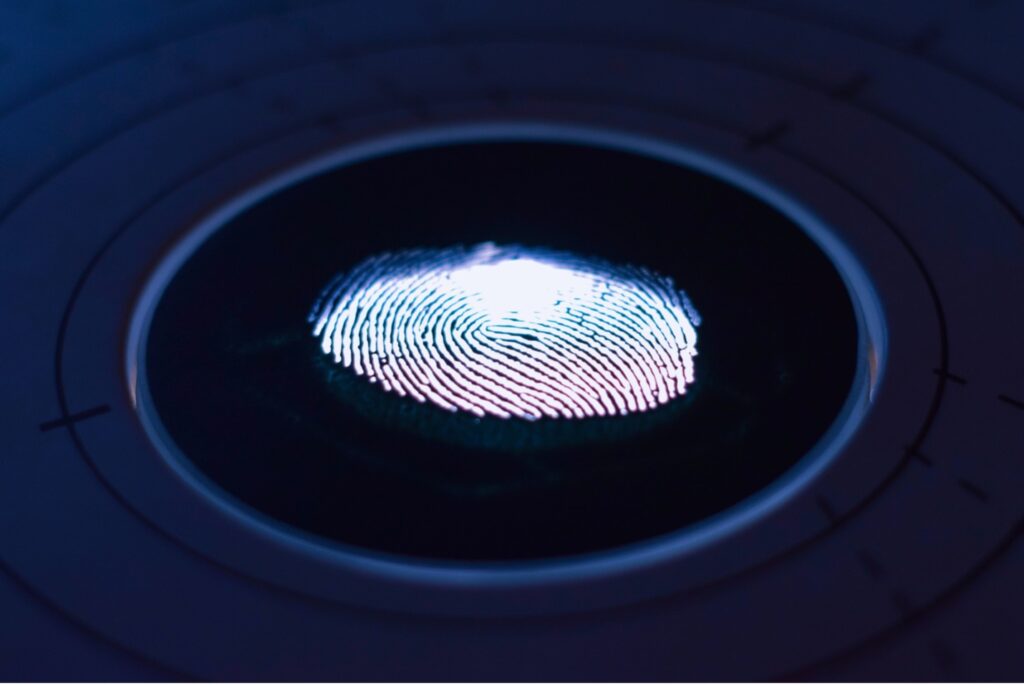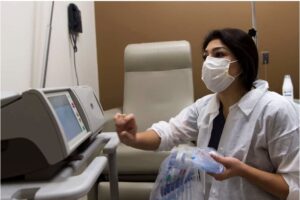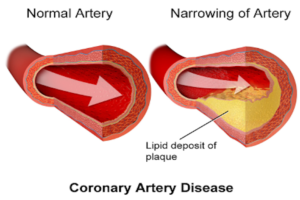This publication is in proud partnership with Project UNITY’s Catalyst Academy 2023 Summer Program.

Source: George Prentzas
Anytime we use our phones, we likely unlock them with our fingerprint or face ID. But rarely does anyone truly consider the technology behind these biometric identification tools and their infinite uses in many fields and everyday activities.
The technology behind biometric identification uses an individual’s physiological and behavioral attributes to authenticate their identity and assess their condition. Data collected can include fingerprints, iris scans, speech, gait, and much more1.
Biometric technology generally has two main uses: recognition and screening. Biometric recognition involves the identification of a person through various details and characteristics, such as fingerprints or iris scans2. This can be utilized to recognize, for example, an unresponsive patient in an emergency.1 Meanwhile, screening generally involves measurements, such as assessing blood pressure, cholesterol levels, blood sugar, and more3. These devices can enhance healthcare and treatment with their real-time assessments, as changes in patient conditions can easily be detected through the data collected4.
Both biometric recognition and screening technology can drastically change the landscape of healthcare and public health through the incorporation of more advanced technological services. This medical innovation is key to saving more lives and improving the quality of and access to treatments5.
Biometrics in the COVID-19 Pandemic
During the COVID-19 pandemic, biometrics were employed in a wide range of activities. During the pandemic especially, since many biometrics are touchless tools, they helped reduce the risk of spreading the virus through contact with various surfaces6.
If you visited a public space during the pandemic, you likely encountered one of the most common uses of biometrics: infrared thermometers that used cameras to determine an individual’s body temperature, without having to come into contact with them. This was especially useful in limiting the transmission of the virus, as those who were sick could be easily identified and prevented from spreading the disease. Some companies further developed infrared temperature tools through which individuals can also be recognized and tagged with infrared thermometers, even when wearing a mask, further allowing easy identification of sick individuals7.
A unique method of COVID-19 diagnosis was also developed with biometrics. Audio recordings of the speech, coughing, and breathing of healthy individuals and COVID-19 patients were analyzed, and a system was built to diagnose those who had COVID-19 through their speech and coughing8. This tool could be especially useful for communities who do not have access to large quantities of COVID tests.
In many public areas, surveillance and CCTV cameras were inbuilt with biometric technology that identified whether individuals were wearing masks, prioritizing the health of the entire community.9 This helped ensure that the more vulnerable populations stayed healthy. While travel was mostly restricted during the pandemic, as the transition to opening airports began, many touchless kiosks and security points were introduced to limit the spread of the virus6.
Biometric technology overall greatly helped reduce the transmission of COVID-19 during the pandemic while also aiding with the diagnosis of COVID-19. However, biometrics also has a profound effect on our daily health, even after the pandemic.
Wearable Technology
Biometric technology is also embedded into many of the smartwatches we wear every day, such as Fitbits and Apple Watches. Not only do they track fitness metrics such as steps and calories, but also heart rate, sleep, stress levels, and many other health metrics that can allow the user to be more aware of their health. The biometric technology in smartwatches allows users to more easily set healthy lifestyle goals without the need of spending too much time or money10.
Wearable technology can also help inform healthcare providers about the health status of patients and can help explain any health outcomes. This improves the treatment that patients receive overall, as it will be more personalized to their health11.
Cancer
Early detection of cancer is key to minimizing its effects on the human body. Biometric technology can help streamline and increase the efficiency of the diagnosis and treatment process.
Through biometric technology, the risk factors for cancer can be determined in various demographics12, allowing interventions that target these problems to be implemented. From a public health standpoint, this can help decrease the rates of cancer in especially vulnerable populations and provide that demographic the necessary targeted care.
Biometric technology can also aid with the diagnosis of cancer. Recently, a method of detecting breast cancer through fingerprints was devised, acting as a highly accurate tool for an accessible way to diagnose breast cancer13. This could act as a cost-free and easy way of diagnosis for those that cannot afford more expensive medical bills.
Not only that, during the treatment period, biometric technology, or more specifically wearable technology, can be used to measure and track the side effects that patients face due to cancer treatment. Studies have also found that tracking and reporting various symptoms to doctors can help minimize side effects from cancer treatment14. Biometric technology can thus be incorporated into various parts of the lives of cancer patients to minimize the symptoms. However, especially when biometrics is applied to large scale health operations, the downsides must be carefully evaluated to minimize risk from the technology.
Limitations
Biometric technology has the potential to greatly enhance all aspects of healthcare by offering convenient ways to solve medical issues and make healthcare more accessible to many minorities.
Unfortunately, biometric technology can also decrease access to healthcare for certain groups15. In terms of face recognition technology, biometric technology is 100 times more inaccurate at identifying people of color16. Especially in a healthcare situation, misidentification could be the difference between life and death, so further development of biometrics is necessary.
Along with that, with the use of any technology, especially one that holds confidential information, comes the risk of the invasion of privacy. Biometric technology can be easily hacked by cybercriminals and private healthcare information can be sold on the black market, allowing hackers to profit17. Cybercriminals are not the only ones who are prone to stealing sensitive biometric data, as large companies such as Amazon, Microsoft, Google, and Meta have been charged with profiting from illegally utilizing users’ biometric data for profit on multiple counts18.
In the workforce, employers are beginning to collect more biometric data on the health of employees, leading to workplace discrimination19. For example, if employers gained access to biometric data in femtech platforms, such as period tracking apps, it could cause employers to discriminate based on pregnancy, disproportionately affecting women20.
Despite these limitations, biometric technology has the potential to revolutionize the healthcare industry. Through improvement of the technology by expanding databases, securing information, and increasing regulation, biometric tools can become one of the most accessible ways to enhance the well-being of underserved populations effectively.
References
- Mason, Janelle, Rushit Dave, Prosenjit Chatterjee, Ieschecia Graham-Allen, Albert Esterline, and Kaushik Roy. (2020). “An Investigation of Biometric Authentication in the Healthcare Environment.” Array 8 (December): 100042.
- “Biometric Recognition: Definition, Challenge and Opportunities of Biometric Recognition Systems.” IQUII. March 8, 2018. https://medium.com/iquii/biometric-recognition-definition-challenge-and-opportunities-of-biometric-recognition-systems-d063c7b58209.
- Hecht, Marjorie. (2020). “Biometric Screening: What Is It and What’s Tested?” Healthline. March 11, 2020. https://www.healthline.com/health/what-to-know-about-a-biometric-screening.
- Arnerić, Stephen P., Jesse M. Cedarbaum, Sean Khozin, Spyros Papapetropoulos, Derek L. Hill, Michael Ropacki, Jane Rhodes, et al. (2017). “Biometric Monitoring Devices for Assessing End Points in Clinical Trials: Developing an Ecosystem.” Nature Reviews. Drug Discovery 16 (10): 736.
- Worthy, Stacey. (2014). “Fifty Million Life-Years Saved through Medical Innovation.” The Hill, December 5, 2014. https://thehill.com/blogs/congress-blog/healthcare/226042-fifty-million-life-years-saved-through-medical-innovation/.
- Mungovan, Robert M. (2021). “Biometrics Are Here to Stay Long after the Pandemic.” Security Info Watch. September 22, 2021. https://www.securityinfowatch.com/access-identity/biometrics/article/21239441/biometrics-are-here-to-stay-long-after-the-pandemic.
- Van Natta, Meredith, Paul Chen, Savannah Herbek, Rishabh Jain, Nicole Kastelic, Evan Katz, Micalyn Struble, Vineel Vanam, and Niharika Vattikonda. (2020). “The Rise and Regulation of Thermal Facial Recognition Technology during the COVID-19 Pandemic.” Journal of Law and the Biosciences 7 (1): lsaa038.
- Gomez-Barrero, Marta, Pawel Drozdowski, Christian Rathgeb, Jose Patino, Massimiliano Todisco, Andreas Nautsch, Naser Damer, Jannier Priesnitz, Nicholas Evans, and Christoph Busch. (2022). “Biometrics in the Era of COVID-19: Challenges and Opportunities.” IEEE Transactions on Technology and Society 3 (4): 307–22.
- Carlaw, Stuart. (2020). “Impact on Biometrics of Covid-19.” Biometric Technology Today 2020 (4): 8–9.
- “Fitbits of the Future: What’s next for Biometric Data in Health?” n.d. Accessed June 25, 2023. https://www.aetnainternational.com/en/about-us/explore/future-health/fitbit-biometric-tech-health-care.html.
- Izmailova, Elena S., and William A. Wood. (2021). “Biometric Monitoring Technologies in Cancer: The Past, Present, and Future.” JCO Clinical Cancer Informatics 5 (June): 728–33.
- “NCI Dictionary of Cancer Terms.” 2011. National Cancer Institute. February 2, 2011. https://www.cancer.gov/publications/dictionaries/cancer-terms/def/biometrics.
- “Fingerprint Breakthrough in Breast Cancer Detection.” (2023). Doncaster and Bassetlaw Teaching Hospitals. Doncaster and Bassetlaw Teaching Hospitals NHS Foundation Trust. February 20, 2023. https://www.dbth.nhs.uk/news/fingerprint-breakthrough-in-breast-cancer-detection/.
- Holländer-Mieritz, Cecilie, Ivan R. Vogelius, Claus A. Kristensen, Allan Green, Judith L. Rindum, and Helle Pappot. (2021). “Using Biometric Sensor Data to Monitor Cancer Patients During Radiotherapy: Protocol for the OncoWatch Feasibility Study.” JMIR Research Protocols 10 (5): e26096.
- “Biometric Bias in the Transgender and Non-Binary Community.” Future Identity. November 22, 2022. https://thefutureidentity.com/biometric-bias-in-the-transgender-and-non-binary-community/.
- “Man Wrongfully Arrested Because Face Recognition Can’t Tell Black People Apart.” (2020). American Civil Liberties Union. June 24, 2020. https://www.aclu.org/press-releases/man-wrongfully-arrested-because-face-recognition-cant-tell-black-people-apart.
- Sayce, Scott. “Cyber Security: The Future Risk of Biometric Data Theft.” April 13, 2018. Accessed July 1, 2023. https://www.cnahardy.com/news-and-insight/insights/english/cyber-securit-the-future-risk-of-biometric-data-theft.
- Morrison, Ryan. (2022). “Amazon Lawsuits Could Dictate the Future of Biometric Data.” Tech Monitor. May 13, 2022. https://techmonitor.ai/policy/privacy-and-data-protection/amazon-biometric-data-jeff-bezos.
- Jeong, Soojin. (2021). “Could Biometric Tracking Harm Workers?” The Regulatory Review. December 9, 2021. https://www.theregreview.org/2021/12/09/jeong-could-biometric-tracking-harm-workers/.
- Brown, Elizabeth. (2020). “Supercharged Sexism: The Triple Threat of Workplace Monitoring for Women.” https://doi.org/10.2139/ssrn.3680861.
Related Posts
The Effects of Affirmative Action on Healthcare Diversity
This publication is in proud partnership with Project UNITY’s Catalyst...
Read MoreStrength in Numbers: How Community Enhances Perceived Support
Figure 1: Bandmates join in a group hug. The powerful...
Read MoreThe Public Health Implications of Chronic Kidney Disease in San Diego
This publication is in proud partnership with Project UNITY’s Catalyst Academy 2024...
Read MoreGender Differences in Health and Medicine and the Importance of Gender-Specific Medicine in Healthcare Policy
This article was originally submitted to the Modern MD competition...
Read MoreCOVID-19 and its Implications for Adolescent Mental Health
Covid 19 and Isolation (Source: created by author) Abstract The...
Read MoreCOVID-19 Clinical Trials and Racial Disproportionality
Figure 1: A doctor drawing blood from a patient as...
Read MoreSmriti Kumar






